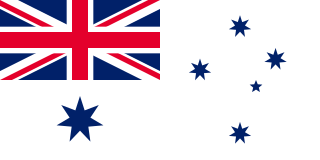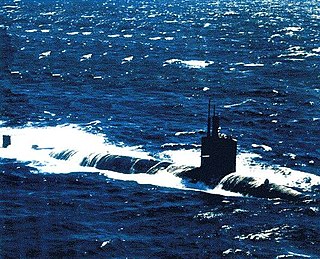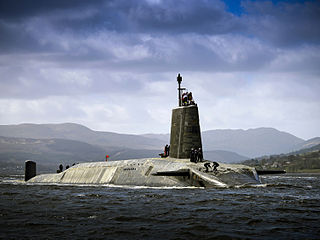Related Research Articles

The Royal Australian Navy (RAN) is the principal naval force of Australia, a part of the Australian Defence Force (ADF) along with the Australian Army and Royal Australian Air Force. The Navy is commanded by the Chief of Navy (CN), who is subordinate to the Chief of the Defence Force (CDF) who commands the ADF; the current CN is Vice Admiral Michael Noonan. The CN is also directly responsible to the Minister of Defence, with the Department of Defence administering the ADF and the Navy.

The Royal Norwegian Navy is the branch of the Norwegian Armed Forces responsible for naval operations of Norway. As of 2008, the Royal Norwegian Navy consists of approximately 3,700 personnel and 70 vessels, including 4 heavy frigates, 6 submarines, 14 patrol boats, 4 minesweepers, 4 minehunters, 1 mine detection vessel, 4 support vessels and 2 training vessels. It also includes the Coast Guard.

USS Ohio (SSBN-726/SSGN-726), the lead boat of her class of nuclear-powered fleet ballistic missile submarines (SSBN), is the fourth vessel of the United States Navy to be named for the U.S. state of Ohio. She was commissioned with the hull designation of SSBN-726, and with her conversion to a guided missile submarine she was re-designated SSGN-726.

USS Skate (SSN-578), the third submarine of the United States Navy named for the skate, a type of ray, was the lead ship of the Skate class of nuclear submarines. She was the third nuclear submarine commissioned, the first to make a completely submerged trans-Atlantic crossing, the second submarine to reach the North Pole, and the first to surface there.

USS Michigan (SSBN-727/SSGN-727) is an Ohio-class nuclear-powered guided missile submarine (SSGN), converted from a ballistic missile submarine (SSBN), that is part of the United States Navy. She is the third vessel to bear the name of the U.S. state of Michigan.

ORP Orzeł was the lead ship of her class of submarines serving in the Polish Navy during World War II. Her name means "Eagle" in Polish. The boat is best known for the Orzeł incident, her escape from internment in neutral Estonia during the early stages of the Second World War.

HMAS Farncomb is the second of six Collins-class submarines operated by the Royal Australian Navy (RAN). Named for Rear Admiral Harold Farncomb, the submarine was laid down in 1993 and launched in December 1995—the first submarine to be completely constructed in Australia. A combination of factors led to Farncomb being the only vessel of her class in operational condition in mid-2009.

USS Wyoming (SSBN-742) is a United States Navy Ohio-class ballistic missile submarine which has been in commission since 1996. She is the fourth U.S. Navy ship to be named USS Wyoming, although it was only the third named after the state of Wyoming.

USS Batfish (SSN-681), a Sturgeon-class submarine, was the second ship of the United States Navy to be named for the batfish.

USS Hunt (DD-194) was a Clemson-class destroyer in the United States Navy following World War I. She also served in the United States Coast Guard, as USCGD Hunt (CG-18). She was later transferred to the Royal Navy as HMS Broadway (H90).

Women have served in the military in many different roles in various jurisdictions throughout history. Women in many countries are no longer excluded from some types of combat mission such as piloting, mechanics and infantry officer. Since 1914, in western militaries, women have served in greater numbers and more diverse roles than before. In the 1970s, most Western armies began allowing women to serve in active duty in all military branches. In 2006, eight countries conscripted women into military service. In 2013, Norway became the first NATO country to draft women, as well as the first country in the world to conscript women on the same formal terms as men. In 2017, neighboring Sweden followed suit and in 2018, the Netherlands joined this line-up.

HMSVigilant is the third Vanguard-class submarine of the Royal Navy. Vigilant carries the Trident ballistic missile, the United Kingdom's nuclear deterrent.

HNoMS Kjell was the final ship of twenty-seven 2nd class torpedo boats built for the Royal Norwegian Navy, launched at the Royal Norwegian Navy's shipyard in Horten on 12 March 1912 with build number 106. Kjell saw more than 32 years of service, the first 28 years in the Royal Norwegian Navy during the First World War and in the interwar period, the last four in the Kriegsmarine, having been captured in the first days of the 1940 Norwegian campaign. After being rebuilt as a minesweeper by the Germans, she was sunk by Royal Air Force de Havilland Mosquito fighter bombers on 28 September 1944. Divers rediscovered the shipwreck in 2006.

The Royal Navy Submarine Service is one of the five fighting arms of the Royal Navy. It is sometimes known as the Silent Service, as submarines are generally required to operate undetected.
This list is about women in warfare and the military from 1945 to 1999.

HMS Sturgeon was an S-class submarine that entered service with the Royal Navy in 1932. Ordered in 1930, she was laid down at Chatham Dockyard in January 1931 and launched on 8 January 1932. Commissioned on 27 February 1933, Sturgeon was assigned to the 2nd Submarine Flotilla.

HMS Syrtis was a third-batch S-class submarine built for the Royal Navy during the Second World War. Completed in 1943, Syrtis spent most of her career in the Arctic, off Norway, other than a single patrol in the Bay of Biscay,

HMS Tigris was a T-class submarine of the Royal Navy. She was laid down at Chatham Dockyard and launched in October 1939.

USS Dixon (AS-37) was an L. Y. Spear-class submarine tender, in service to the United States Navy from 1971 through 1995. Dixon was named for George E. Dixon, commander of the Confederate submarine H. L. Hunley.

Many women have served in the United States Navy for over a century. As of 2020, there were 69,629 total women on active duty in the US Navy, with 11,076 serving as officers, and 58,553 enlisted. Of all the branches in the US military, the Navy has the second highest percentage of female active duty service members with women making up 20% of the US Navy in 2020.
References
- ↑ Cdr Debbie Pestell, MD. "Experiences with Mixed Gender Submarine Crews". Ftp.rta.nato.int. Archived from the original on 26 February 2013. Retrieved 18 February 2015.
- ↑ "Verdens første kvinnelige ubåtsjef" (in Norwegian). Norwegian News Agency. 11 September 1995.